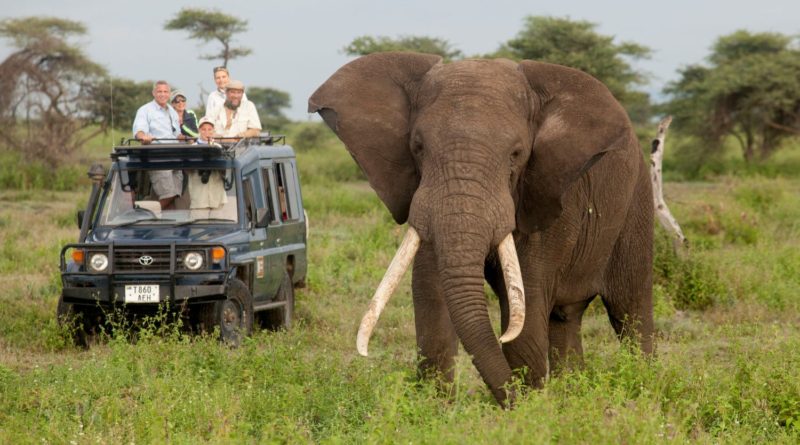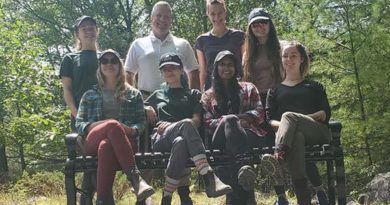Where to See East Africa Wildlife on Safari: Kenya & Tanzania

© David Luck
Many adventurers who love both wildlife and travel may have had “African safari” written at the top of their bucket list for quite some time. But considering Africa is three times the size of the United States —and each African country is filled with its own unique richness and diversity of wildlife—it may be tricky to even know where to begin trip planning.
If what you picture in your head is the classic silhouette of a giraffe calmly munching on acacia leaves with a vivid orange sunset making the sky glow like fire behind it, primal lions hungrily prowling through swaying grass and elephants roaming the savanna with their young, classic East Africa is where you need to head. Home to the iconic Big Five of the Cape buffalo, leopard, lion, elephant and rhinoceros, this region is also home to a Little Five, named after their larger counterparts: the buffalo weaver, leopard tortoise, antlion, elephant shrew and rhinoceros beetle.
To ensure you see as many of these majestic creatures as possible, it’s best to combine multiple locations within Kenya and neighboring Tanzania. If you can do so during the dramatic Great Migration where millions of wildebeest and zebra make their way from the Serengeti to the Maasai Mara as they follow the rains in search of lush grazing grounds, even better.
Here are our top picks for four of the very places to see wildlife on an East African safari.
Maasai Mara National Reserve
The Maasai Mara is a 580-square mile wildlife reserve in Narok County, Kenya, and is considered the northern extension of the Serengeti National Park in northern Tanzania. In addition to being a main location of the Great Migration from the dry season of July to October when you can spot zebra, gazelle and wildebeest in droves, the Maasai Mara also has an extraordinarily large population of predators that includes lions, leopards and cheetahs. The remaining members of the Big Five—Cape buffalo, elephant and rhino—also make the Maasai Mara home, as well as around 570 unique bird species. More than 50 of these are birds of prey, such as eagles, storks and vultures.

While a small part of today’s park was originally established as a wildlife sanctuary back in 1961, the Maasai people have been caretaking the land for centuries prior. While they believe that the land is an important part of their lives, they also believe they are an integral part of the life of the land. With this as a foundation, they rarely hunt and do their best to live in harmony with wildlife, considering themselves fierce guardians of the ecosystem. On our Nat Hab East Africa Safari, if conditions allow, we sometimes have the privilege to spend time with the locals on a Maasai naturalist-guided bush walk to see nature through their eyes.

© Mark Hickey
The Maasai Mara has four main kinds of topography to explore. There is sandy soil and small bushes to the east and the Siria Escarpment that forms a spectacular plateau as the western boundary of the reserve. (Fun fact: the movie Out of Africa was filmed on top of the Siria in 1985.) In addition, there are lush grasslands and woodlands around the Mara River and open plains with scattered bushes making up the biggest part of the reserve. Thanks to its moderately high altitude, which ranges from 4,900 to 7,100 feet above sea level, the daytime temperature in the Maasai Mara rarely hits above the high 70s all year long. This makes it quite a pleasant destination for safari.
Serengeti National Park
Serengeti National Park is a World Heritage Site chock full of wildlife. This spectacular place is made up of a whopping 5,800 square miles of grassland plains, dramatic rocky outcrops and acacia woodlands and is home to more than 2 million ungulates, roughly 4,000 lions, 1,000 leopards, 550 cheetahs and some 500 bird species.

Because of the size of this park, it’s best to experience it from a private mobile camp if possible. This means you’ll have the opportunity to follow the wildlife and set up camp at the most opportune locations—and in migration season, that means close to a main migration corridor. The Serengeti offers up-close-and-personal predator-prey interaction. It’s not uncommon to be able to watch a powerful lion take down a lagging wildebeest or spot an ultra-fast cheetah overtaking a young antelope. Lucky guests may even encounter an elusive leopard in a riverine forest.
On the eastern part of the Serengeti, there’s the Ngare Nanyuki underground river, which creates pockets of permanent water that support year-round wildlife concentrations, making this park reliable for wildlife spotting. Until recently, this specific area was set aside for scientific research into predators, especially cheetah, but our Nat Hab Safari guests are now able to enjoy that same access to this dense feline population.

On the water note, water crossings are one of the most dangerous obstacles for wildebeest and are always dramatic to watch during the migration, as hippos and Nile crocodiles sit at many river crossings, patiently waiting for prey.
Ngorongoro Conservation Area—Ngorongoro Crater
Deserving of its title as of the Seven Natural Wonders of Africa, Ngorongoro Crater in northern Tanzania (southeast of Serengeti) hosts Africa’s densest concentration of wildlife, which is attracted to the crater’s perpetual water sources. With steep, 2,000-foot walls that surround a crater floor that is 12 miles across, it is the largest unbroken caldera on Earth!

© Hendrik Cornelissen
Ngorongoro Crater is often referred to as ‘the Garden of Eden’ because it is such a paradise for animals. Approximately 30,000 animals live on the lush crater floor, including buffalo, elephants, giraffes, zebra, wildebeest, eland, gazelle and the predators that pursue them, like lions (here it’s sometimes possible to spot black-maned male lions!), leopards, cheetahs and hyenas. If you’re lucky, you may even spy one of the few endangered black rhinos that hang out inside the crater. Birdlife is not only abundant, but colorful: gigantic flocks of flamingos make the surface of the soda lakes appear bright pink.
It’s one thing to be on safari down on the crater floor, but it’s a whole other experience to look down on the crater floor from the surrounding highlands. You can begin to get a better idea of just how many animals there are roaming in the smallish area. Livestock belonging to the semi-nomadic Maasai tribe graze alongside wild animals, making for an interesting mix.
In addition to being a hotspot for wildlife, the Ngorongoro Conservation Area is also one of the most important prehistoric sites in the world. Olduvai Gorge, located in the Conservation Area, was the location for a major archaeological discovery in the 1950s, whose fossils are said to be the earliest known evidence of the human species and hugely furthered our understanding of evolution.
Ol Pejeta Conservancy
Located on the Laikipia Plateau in the shadow of Mount Kenya, Ol Pejeta is a conservation success story. In 2014, Ol Pejeta achieved IUCN Green List status, one of only two conservancies in Africa to be recognized in this way. It used to function as a working cattle ranch that started during Kenya’s colonial days, but in 1988, 90,000 acres of land were set aside for not-for-profit rhino conservation.

At the hands of European hunters and settlers, black rhino numbers dropped by a sobering 98% between 1960 and 1995 (to less than 2,500 individuals) and Ol Pejeta knew that it was time to take action. It is now not only the largest black rhino sanctuary in East Africa, but also home to the world’s last two remaining northern white rhinos (which we visit on our Nat Hab East Africa Safari).
Wildlife crime like poaching and the black-market trafficking of rhino horn for so-called medicinal uses continues to plague the critically endangered species and threaten its recovery, making the work that Ol Pejeta does just as important today as when it began its conservation efforts. Ol Pejeta’s noble mission is not only to preserve the biodiversity within its 90,000 acres, but it also puts heavy focus on supporting the local people. This is to ensure that wildlife conservation tangibly translates to better education, healthcare and infrastructure for the next generation of wildlife guardians.




